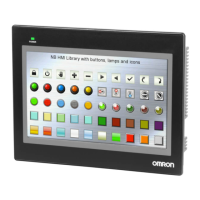3-319
3 Functions of NB-Designer
NB-series Programmable Terminals NB-Designer Operation Manual(V106)
3-11 Address of System Memory
3
3-11 Address of System Memory
The system reserves some addresses of Local Word (LW), Local Bit (LB), Nonvolatile Local Word (LW)
for the special purposes, and the user must use these memory addresses according to the related
descriptions.
• Local Bit (LB): The reserved range is from LB9000 to LB9999.
• Local Word (LW): The reserved range is from LW9000 to LW9999.
• Nonvolatile Local Word: The reserved range is from LW10000 to LW10255.
Descriptions of internal BIT memory:
LB: Refers to the local bit address of PT, which can’t be retained when power is OFF.
RB: Refers to the absolute address of bit address saved in the recipe memory that is stored in the flash
memory, which can be retained when the power is OFF. Even if the battery is dead in PT, the data
stored in the recipe memory will not be lost.
RBI: Refers to the index address of bit address saved in the recipe memory that is stored in the flash
memory, which can be retained when the power is OFF. Even if the battery is dead in PT, the data
stored in the recipe memory will not be lost.
LW.B: Refers to the bit address corresponding to the local word address of PT, which can’t be retained
when the power is OFF.
FRB: Refers to the absolute address of bit address saved in Flash, which can be retained when the
power is OFF. When the battery is dead in PT, the data saved in Flash will not be affected, but the
number of write operations in Flash is limited.
FRBI: Refers to the index address of bit address saved in Flash, which can be retained when the power
is OFF. When the battery is dead in PT, the data saved in the Flash will not be affected, but the number
of write operations in Flash is limited.
Descriptions of internal WORD memory:
LW: Refers to the local word address of PT, which can’t be retained when power is OFF.
RW: Refers to the absolute address saved in the recipe memory that is stored in the flash memory,
which can be retained when the power is OFF. Even if the battery is dead in PT, the data stored in the
recipe memory will not be lost.
RWI: Refers to the index address saved in the recipe memory that is stored in the flash memory, which
can be retained when the power is OFF. Even if the battery is dead in PT, the data stored in the recipe
memory will not be lost.
FRW: Refers to the absolute address of word address saved in Flash, which can be retained when the
power is OFF. When the battery is dead in PT, the data saved in Flash will not be affected, but the
number of write operations in Flash is limited.
FRWI: Refers to the index address of word address saved in Flash, which can be retained when the
power is OFF. When the battery is dead in PT, the data saved in the Flash will not be affected, but the
number of write operations in Flash is limited.
Note RB and RW point to the same area. For example, RB5.0 to RB5.F and RW5 map the same area, i.e. RB5.0
is the Bit0 of RW5. But LB and LW map different areas, and the addresses pointed by them in the memory
are different.

